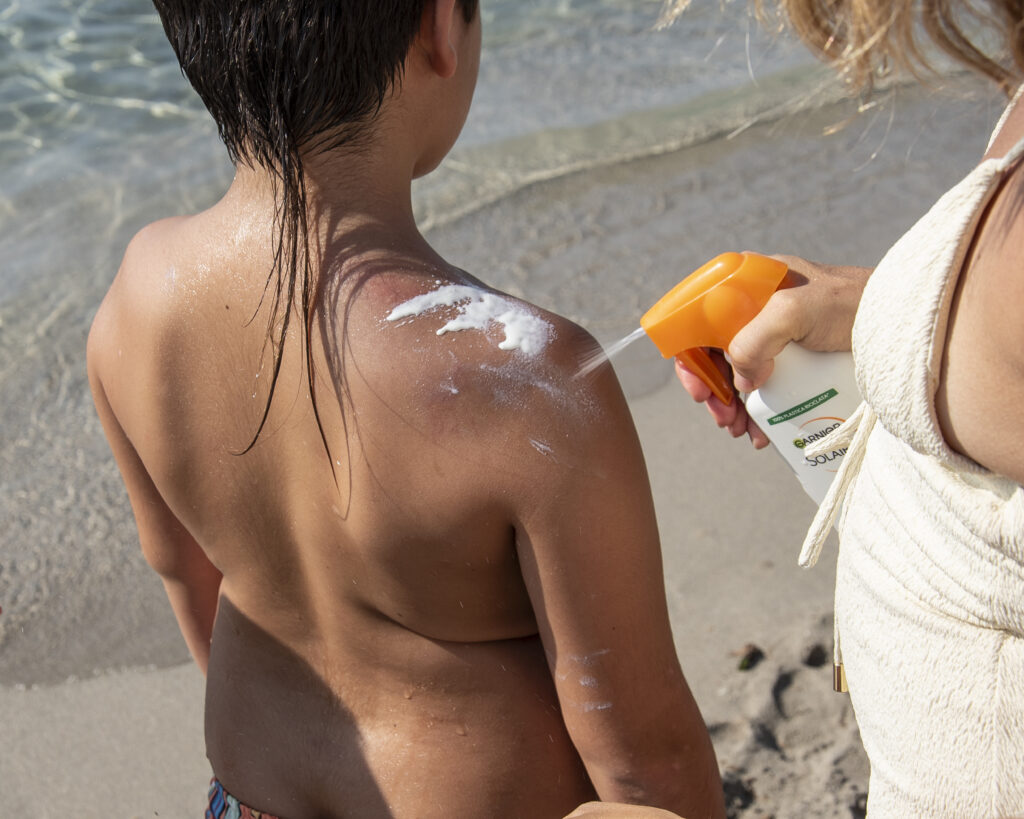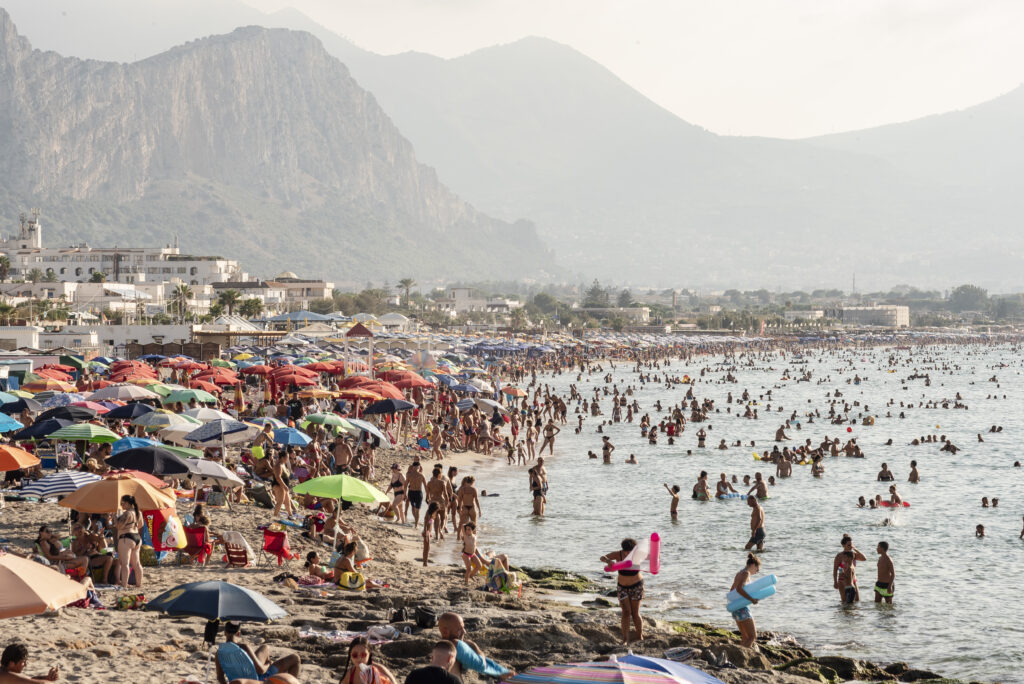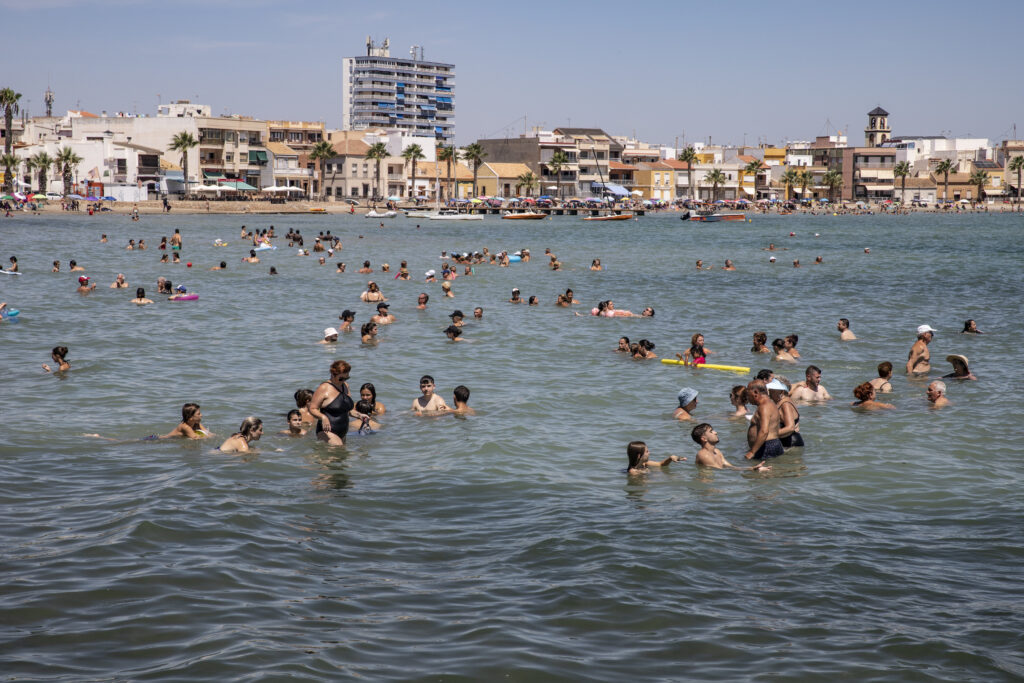The Not-So-Sunny-Side of Sunscreen
Sunscreen pollution is altering Mediterranean ecosystems. We may see impacts on human health in the future.
Catchy and repetitive, few things are more enduring than a summer hit song. But pop melodies are not the only trace of summer that remains along Mediterranean shores once the leaves have turned and the tourists have left: Just like a chorus we can’t get out of our heads, sunscreen – in particular, the different mineral and chemical components it contains – linger on well beyond the summer season.
Sunscreen is essential for protecting the skin from harmful UV rays and is considered an indispensable item for a day of beachgoing. However, over the last decade, different scientific studies have shown that sunscreen components can seriously affect marine biodiversity and may also pose a risk to human health. According to estimates from marine biologists, more than 20,000 tonnes of sunscreen end up in Mediterranean waters each year, interfering with the growth and reproduction of microalgae, mussels, sea urchins, crustaceans, corals, and even fish and sea turtles.
…more than 20,000 tonnes of sunscreen end up in Mediterranean waters each year, interfering in the growth and reproduction of microalgae, mussels, sea urchins, crustaceans, corals, and even fish and sea turtles.
Every summer, the Mediterranean coasts fill with tourists who come to relax on their beaches. France and Spain alone received more than 190 million international visitors in 2024. With an area of approximately 2.5 million km² and an average depth of 1,500 metres – but reaching up to 5,400 metres in some places – the Mediterranean Sea not only influences the climate and lifestyle of 20 countries, but also boasts a vast marine diversity, with more than 17,000 aquatic species. And while it may not be apparent to the naked eye, the Mediterranean is also one of the areas most affected by pollution, exacerbated by the fact that it is nearly an enclosed body of water, linked with the Atlantic only through the narrow Strait of Gibraltar.

The sources of Mediterranean pollution are multiple: plastics and microplastics (now ubiquitous the world around), industrial discharge, fossil fuel waste, and general refuse, just to name a few. And while there is European Union legislation regarding the potential human health impacts caused by some of these pollutants, many others have yet to be regulated
How does sunscreen impact the environment?
Sunscreen contamination stems primarily from the active chemical ingredients different sunscreens and sun creams contain, such as oxybenzone, octocrylene, octinoxate, and homosalate. These compounds are found in many cosmetic products as well; by absorbing UV rays, they prevent them from reaching the skin. While these compounds have grown ubiquitous since the mid-20th century, the environmental consequences of their ever-growing presence are just starting to be studied.
“Everything indicates that these are global contaminants,” explains Antonio Tovar of the Institute of Marine Sciences of Andalusia in Cádiz, Spain. “We still don’t know the scale or the effect that they may be having.” Tovar and his colleague Araceli Rodríguez have been researching sunscreen pollution in marine ecosystems for over a decade and are among the leading experts in this field.
However, they are hesitant to generate public alarm over their findings. “We never want to give the message not to use sunscreen because we would be going against the medical advice of every dermatologist,” Tovar clarifies. “We are not doctors, we are scientists, so we limit ourselves to simply saying that this is having an environmental impact.”
Many sunscreen labels boast that their contents are “eco-friendly”, “reef-safe” or “reef-friendly”. However, such promises don’t always turn out to be true. “Today, there are no regulations defining what an ‘eco-friendly’ sunscreen actually is,” Rodríguez clarifies. “We can find products on the market with logos that claim they ‘protect oceans’ but they are based on each manufacturer’s own criteria. Each sunscreen has its own formula.”
At the Institute of Marine Sciences of Andalusia, Rodríguez leads a project focused on developing a battery of ecotoxicological tests to predict the impact of sunscreens on marine ecosystems. Her goal is to share the results with cosmetics companies so they can create sunscreens with the lowest possible environmental impacts. “We need to create a product that is as environmentally friendly as possible, but that also protects our skin.”
Working directly with cosmetic companies seems to be an effective way to try to unite the interests of the industry, consumers, and environmental stewardship. However, it is a slow and difficult task, largely because of a lack of environmental regulations concerning sunscreen, and also because no company wants to give up a successful business model.
Protecting marine ecosystems from sunscreen pollution
The environmental impact of sunscreens in marine ecosystems is undeniable. In Hawaii as of 2021, the sale and use of sunscreens containing oxybenzone or octinoxate have been banned in response to their proven link to coral bleaching, a consequence of DNA damage that disrupts growth and reproduction. Additionally, Thailand and Palau have also taken measures to restrict or ban the use of sunscreens containing ingredients harmful to local marine ecosystems.

In Europe, however, similar regulations remain absent. In 2015, members of the European Parliament submitted a motion calling on Member States to ban oxybenzone, which is also known as benzophenone-3, but a definitive resolution was never reached. A 2021 opinion by the European Commission’s Scientific Committee on Consumer Safety concluded that the use of a product containing oxybenzone in concentrations above 6% posed a risk, but this is yet to translate into any formal restrictions, leaving Mediterranean ecosystems exposed.
Components like oxybenzone and octocrylene are not the only active ingredients used in sunscreens; in addition to these chemical UV blockers, mineral components such as and zinc oxide (ZnO) and titanium dioxide (TiO2), also offer effective sun protection by deflecting UV rays rather than absorbing them. While some look to mineral based sunscreens as more ecological alternatives, their “eco-friendliness” is far from being scientifically verified.
In 2024 Cintia Corinaldesi, a marine biologist and ecologist at the Polytechnical University of the Marches in Ancona, Italy and researcher for The National Biodiversity Future Center, conducted a study analysing the effects of four sunscreens labelled “eco-friendly”, “reef-safe”, and “sea-safe” on sea urchin embryos. Of the four, three caused growth delays in the embryos, producing adverse impacts in their early stages of development that correspond to endocrine disruptors. Despite being classified as “eco-friendly” or “reef-safe”, sunscreens containing ZnO and TiO2 were not shown to be more environmentally friendly than those containing chemical UV filters like oxybenzone and octocrylene.
Despite being classified as “eco-friendly” or “reef-safe”, sunscreens containing ZnO and TiO2 were not shown to be more environmentally friendly than those containing chemical UV filters like oxybenzone and octocrylene.
“TiO2 is the same mineral used in wastewater treatment plants,” explains Antonio Tovar. “And it has a particular property: it produces hydrogen peroxide, which is reactive when in contact with sunlight. It’s like when you put hydrogen peroxide on a wound and it bubbles: it degrades organic matter. A long time ago, we realised that TiO2 could cause skin cancer, so the solution was to encapsulate it in silica and alumina in order to protect the skin from this reactivity. But what happens when this encapsulated TiO2 reaches the sea? Its capsule dissolves immediately, unleashing harmful effects on the marine environment.”
Sunscreen and tourism
The onset of negative effects of sunscreen components on marine species is largely a question of time and volume: the presence of ever-increasing numbers of beachgoing tourists – and more and more of the sunscreen they wear – year after year, sustained for decades.
The first records of topical protection against solar UV rays date back millennia. During ancient times, the Egyptians covered themselves with jasmine, rice bran, and lupine flowers to protect their skin, while the Greeks covered themselves with olive oil, which has a sun protection factor (SPF) of around eight.
According to the U.S. National Library of Medicine, the first modern sunscreen was created in Stuttgart, Germany, in 1891, made with quinine and lotion. During the first decades of the 20th century, various scientific investigations linking sun exposure with cutaneous melanoma led to the emergence of new sunscreen recipes. At the same time, in many European countries, a tanned skin – historically associated with agricultural labour and the peasantry who performed it – began to take on a new meaning: in industrialised societies, where a large portion of the working class spent long hours in toiling under factory roofs, a sun-kissed complexion became a sign of leisure and privilege.
In the 1930s, Eugène Schueler, chemist and founder of the multinational cosmetics company L’Oréal, developed “Ambre Solaire”, a tanning lotion based on benzyl salicylate that filtered UV rays. In the following decade, new formulas appeared under a variety of brand names, some of which – Coppertone, Piz Buin – are still marketed today. During the post-World War II boom in sun and beach tourism, the working classes began flocking to the Mediterranean coasts, and sunscreen became an essential product for long days by the sea.

Although the main way polluting sunscreen components reach seas and oceans is via beachgoers, it’s not the only way. They also travel via urban wastewater systems.
“Sunscreen also reaches the sea directly through the shower drain,” says Victor León, researcher at the Spanish Oceanographic Institute who works on the issue of marine pollution. “Although wastewater treatment plants eliminate a very high percentage, 99%, is eliminated, 1% still escapes. If the amount used is very large, that 1% can be a significant continuous mass. What we need to see is whether these compounds accumulate and in what concentrations they produce negative effects,” he explains.
Continuing research to protect human and ecosystem health
Today León participates in several EU-level projects focused on investigating the impact of various emerging pollutants, which include sunscreens. “If it becomes clear that there is a negative environmental impact, there will be steps backward,” explains León. “We can reduce a chemical to a certain limit or even ban it if necessary. There is much more control and monitoring with agricultural pesticides because food products treated with pesticides are consumed directly.”
León draws a comparison between sunscreen and dichloro-diphenyl-trichloroethane, more commonly known as DDT, a pesticide widely used throughout the first half of 20th century to combat malaria and yellow fever. First championed as landmark scientific development – its effectiveness afforded its inventor a Nobel Prize – over time the long-term health and environmental effects of DDT exposure slowly became apparent, among them neurological and reproductive alterations in warm-blooded species, including humans. The 1962 publication of Rachel Carson’s Silent Spring, considered to be one of environmentalism’s founding texts, presented extensive evidence demonstrating DDT’s harmful effects. A decade later, what had once been considered a miracle chemical was banned by the United States Environmental Protection Agency, a move followed by the European Economic Community in 1988.
Today research into the impact of so-called emerging pollutants is increasingly frequent, although the list of these compounds continues to grow. Recently, commonly used pharmaceuticals have been detected in Mediterranean cetaceans. Emma Martínez López, professor of toxicology at the Faculty of Veterinary Medicine at the University of Murcia explains that, “Often we find something because we decide to look for it.” Marine mammals “are not only indicators of ocean health, but also indicators of human health, but you have to know how to interpret the data.”
The discovery of components of ultraviolet filters in corals or bivalves, and traces of antibiotics or anti-inflammatory drugs in dolphins or whales, are just another example of how environmental pollution can affect different ecosystems and cannot be considered an isolated issue.
…the scientific community has finally understood that human health, environmental health, and animal health are closely related.
“Somehow, the scientific community has finally understood that human health, environmental health, and animal health are closely related. That we have a lot in common and that we can provide feedback. Even if we work in isolation, we all have a lot to contribute to each other,” she says.
This article was developed with the support of Journalismfund Europe.
